Design of Power Location Coefficient System for 6G Downlink Cooperative NOMA Network
Abstract
1. Introduction
- The OPs of a two-user NOMA and a cooperative NOMA system are expressed approximately in closed form via theoretical analyses with different distances and power location coefficients. Additionally, through simulation, we show that the derived OP expressions are more precise than those in [13].
- We analyzed the findings of OP and impact power location coefficients in the cooperative NOMA system using a 16 × 16, a 32 × 23, and a 64 × 64 MIMO and compared them to our previous results and improvement calculations.
- We calculated the improved OP performance rate and mitigated the power location coefficient’s impact on far users by a cooperative NOMA combined with a 128 × 128, a 256 × 256, and a 512 × 512 massive MIMO.
2. Related Work
3. Cooperative NOMA System Model
3.1. Direct Transmission Slot
3.2. Relaying Slot
3.3. Diversity Combining
4. Simulation Results and Discussions
5. Conclusion and Future Work
Author Contributions
Funding
Data Availability Statement
Acknowledgments
Conflicts of Interest
References
- Li, A.; Lan, Y.; Chen, X.; Jiang, H. Non-orthogonal multiple access (NOMA) for future downlink radio access of 5G. China Commun. 2015, 12, 28–37. [Google Scholar] [CrossRef]
- Mukhtar, A.M.; Saeed, R.A.; Mokhtar, R.A.; Ali, E.S.; Alhumyani, H. Performance Evaluation of Downlink Coordinated Multipoint Joint Transmission under Heavy IoT Traffic Load. Wirel. Commun. Mob. Comput. 2022, 2022, 6837780. [Google Scholar] [CrossRef]
- Ahmed, M.A.; Mahmmod, K.F.; Azeez, M.M. On the performance of non-orthogonal multiple access (NOMA) using FPGA. Int. J. Electr. Comput. Eng. 2020, 10, 2151. [Google Scholar] [CrossRef]
- Al-Adwany, M.A. Efficient power allocation method for non orthogonal multiple access 5G systems. Int. J. Electr. Comput. Eng. 2020, 10, 2139. [Google Scholar] [CrossRef]
- Mokhtar, R.A.; Saeed, R.A.; Alhumyani, H. Cooperative Fusion Architecture-based Distributed Spectrum Sensing Under Rayleigh Fading Channel. Wirel. Pers. Commun. 2022, 124, 839–865. [Google Scholar] [CrossRef]
- Budhiraja, I.; Kumar, N.; Tyagi, S.; Tanwar, S.; Han, Z.; Piran, M.J.; Suh, D.Y. A systematic review on NOMA variants for 5G and beyond. IEEE Access 2021, 9, 85573–85644. [Google Scholar] [CrossRef]
- Do, D.-T.; Nguyen, T.-T.T. Impacts of relay and direct links at destinations in full-duplex non-orthogonal multiple access system. Indones. J. Electr. Eng. Comput. Sci. 2022, 26, 269–277. [Google Scholar] [CrossRef]
- Hassan, M.B.; Ali, E.S.; Saeed, R.A. Ultra-Massive MIMO in THz Communications: Concepts, Challenges and Applications. In Next Generation Wireless Terahertz Communication Networks, 1st ed.; CRC Press: Boca Raton, FL, USA, 2021; pp. 267–297. [Google Scholar]
- Oleiwi, H.; Saeed, N.; Al-Raweshidy, H. Cooperative SWIPT MIMO-NOMA for Reliable THz 6G Communications. Netw. J. 2022, 2, 257–269. [Google Scholar] [CrossRef]
- Fang, F.; Zhang, H.; Cheng, J.; Roy, S.; Leung, V.C. Joint user scheduling and power allocation optimization for energy-efficient NOMA systems with imperfect CSI. IEEE J. Sel. Areas Commun. 2017, 35, 2874–2885. [Google Scholar] [CrossRef]
- Satrya, G.B.; Shin, S.Y. Security enhancement to successive interference cancellation algorithm for non-orthogonal multiple access (NOMA). In Proceedings of the 2017 IEEE 28th Annual International Symposium on Personal Indoor, and Mobile Radio Communications (PIMRC), Montreal, QC, Canada, 8–13 October 2017; pp. 1–5. [Google Scholar]
- Li, G.; Mishra, D.; Jiang, H. Cooperative NOMA with incremental relaying: Performance analysis and optimization. IEEE Trans. Veh. Technol. 2018, 67, 11291–11295. [Google Scholar] [CrossRef]
- Singh, S.; Bansal, M. Performance analysis of non-orthogonal multiple access assisted cooperative relay system with channel estimation errors and imperfect successive interference cancellation. Trans. Emerg. Telecommun. Technol. 2022, 32, e4374. [Google Scholar] [CrossRef]
- Srinivasarao, K.; Maruthu, S. Outage analysis of cooperative NOMA system with imperfect successive interference cancellation and channel state information over Rayleigh fading channel. Int. J. Commun. Syst. 2022, in press. [Google Scholar] [CrossRef]
- Jaber, Z.H.; Kadhim, D.J.; Al-Araji, A.S. Medium access control protocol design for wireless communications and networks review. Int. J. Electr. Comput. Eng. 2022, 12, 1711. [Google Scholar] [CrossRef]
- Yang, M.; Chen, J.; Yang, L.; Lv, L.; He, B.; Liu, B. Design and performance analysis of cooperative NOMA with coordinated direct and relay transmission. IEEE Access 2019, 7, 73306–73323. [Google Scholar] [CrossRef]
- Hassan, M.B.; Alsharif, S.; Alhumyani, H.; Ali, E.S.; Mokhtar, R.A.; Saeed, R.A. An enhanced cooperative communication scheme for physical uplink shared channel in NB-IoT. Wirel. Pers. Commun. 2021, 120, 2367–2386. [Google Scholar] [CrossRef]
- Dahi, N.; Hamdi, N. Outage performance of generalized cooperative NOMA systems with SWIPT in nakagami-m fading. J. Commun. Softw. Syst. 2018, 14, 386–391. [Google Scholar] [CrossRef]
- Kader, M.F.; Shahab, M.B.; Shin, S.Y. Exploiting non-orthogonal multiple access in cooperative relay sharing. IEEE Commun. Lett. 2017, 21, 1159–1162. [Google Scholar] [CrossRef]
- Elfatih, N.M.; Hasan, M.K.; Kamal, Z.; Gupta, D.; Saeed, R.A.; Ali, E.S.; Hosain, M.S. Internet of vehicle’s resource management in 5G networks using AI technologies: Current status and trends. IET Commun. 2022, 16, 400–420. [Google Scholar] [CrossRef]
- Saeed, R.A.; Abbas, E.B. Performance evaluation of MIMO FSO communication with gamma-gamma turbulence channel using diversity techniques. In Proceedings of the 2018 International Conference on Computer, Control, Electrical, and Electronics Engineering (ICCCEEE), Khartoum, Sudan, 12–14 August 2018; pp. 1–5. [Google Scholar]
- Han, S.; Chih-Lin, I.; Xu, Z.; Sun, Q. Energy efficiency and spectrum efficiency co-design: From NOMA to network NOMA. IEEE COMSOC MMTC E-Lett. 2014, 9, 21–24. [Google Scholar]
- Lien, S.-Y.; Shieh, S.-L.; Huang, Y.; Su, B.; Hsu, Y.-L.; Wei, H.-Y. 5G new radio: Waveform, frame structure, multiple access, and initial access. IEEE Commun. Mag. 2017, 55, 64–71. [Google Scholar] [CrossRef]
- Luo, S.; Teh, K.C. Adaptive transmission for cooperative NOMA system with buffer-aided relaying. IEEE Commun. Lett. 2017, 21, 937–940. [Google Scholar] [CrossRef]
- Islam, S.R.; Avazov, N.; Dobre, O.A.; Kwak, K.-S. Power-domain non-orthogonal multiple access (NOMA) in 5G systems: Potentials and challenges. IEEE Commun. Surv. Tutor. 2016, 19, 721–742. [Google Scholar] [CrossRef]
- Timotheou, S.; Krikidis, I. Fairness for non-orthogonal multiple access in 5G systems. IEEE Signal Process. Lett. 2015, 22, 1647–1651. [Google Scholar] [CrossRef]
- Manglayev, T.; Kizilirmak, R.C.; Kho, Y.H.; Bazhayev, N.; Lebedev, I. NOMA with imperfect SIC implementation. In Proceedings of the IEEE EUROCON 2017—17th International Conference on Smart Technologies, Ohrid, Macedonia, 6–8 July 2017; pp. 22–25. [Google Scholar]
- Manglayev, T.; Kizilirmak, R.C.; Kho, Y.H. Optimum power allocation for non-orthogonal multiple access (NOMA). In Proceedings of the 2016 IEEE 10th International Conference on Application of Information and Communication Technologies (AICT), Baku, Azerbaijan, 12–14 October 2016; pp. 1–4. [Google Scholar]
- Nguyen, T.; Do, D.-T. Novel multiple access for cooperative networks with nakagami-m fading: System model and performance analysis. Indones. J. Electr. Eng. Comput. Sci. 2020, 19, 233–240. [Google Scholar]
- Van, H.T.; Vo, T.A.; Le, D.H.; Phu, M.Q.; Nguyen, H.-S. Outage performance analysis of non-orthogonal multiple access systems with RF energy harvesting. Int. J. Electr. Comput. Eng. 2021, 11, 4135. [Google Scholar] [CrossRef]
- Ding, Z.; Peng, M.; Poor, H.V. Cooperative non-orthogonal multiple access in 5G systems. IEEE Commun. Lett. 2015, 19, 1462–1465. [Google Scholar] [CrossRef]
- Abdelrahman, Y.T.; Saeed, R.A.; El-Tahir, A. Multiple Physical Layer Pipes performance for DVB-T2. In Proceedings of the 2017 International Conference on Communication, Control, Computing and Electronics Engineering (ICCCCEE), Khartoum, Sudan, 16–18 January 2017; pp. 1–7. [Google Scholar]
- Zhang, Y.; Wang, H.-M.; Yang, Q.; Ding, Z. Secrecy sum rate maximization in non-orthogonal multiple access. IEEE Commun. Lett. 2016, 20, 930–933. [Google Scholar] [CrossRef]
- Zhang, Y.; Wang, H.-M.; Zheng, T.-X.; Yang, Q. Energy-efficient transmission design in non-orthogonal multiple access. IEEE Trans. Veh. Technol. 2016, 66, 2852–2857. [Google Scholar] [CrossRef]
- Ding, Z.; Poor, H.V. Design of massive-MIMO-NOMA with limited feedback. IEEE Signal Processing Lett. 2016, 23, 629–633. [Google Scholar] [CrossRef]
- Ding, Z.; Liu, Y.; Choi, J.; Sun, Q.; Elkashlan, M.; Chih-Lin, I.; Poor, H.V. Application of non-orthogonal multiple access in LTE and 5G networks. IEEE Commun. Mag. 2017, 55, 185–191. [Google Scholar] [CrossRef]
- Liu, Y.; Ding, Z.; Elkashlan, M.; Poor, H.V. Cooperative non-orthogonal multiple access with simultaneous wireless information and power transfer. IEEE J. Sel. Areas Commun. 2016, 34, 938–953. [Google Scholar] [CrossRef]
- Ding, Z.; Fan, P.; Poor, H.V. Random beamforming in millimeter-wave NOMA networks. IEEE Access 2017, 5, 7667–7681. [Google Scholar] [CrossRef]
- Aldababsa, M.; Kucur, O. Outage and ergodic sum-rate performance of cooperative MIMO-NOMA with imperfect CSI and SIC. Int. J. Commun. Syst. 2020, 33, e4405. [Google Scholar] [CrossRef]
- Sanjay, M.; Roy, D.; Kundu, S. Outage analysis for NOMA-based energy harvesting relay network with imperfect CSI and transmit antenna selection. IET Commun. 2020, 14, 2240–2249. [Google Scholar] [CrossRef]
- Wang, Z.; Peng, Z. Secrecy performance analysis of relay selection in cooperative NOMA systems. IEEE Access 2019, 7, 86274–86287. [Google Scholar] [CrossRef]
- Shashank, S.; Muralikrishnan, S.; Sheetal, K. Outage Probability of Uplink Cell-Free Massive MIMO Network with Imperfect CSI Using Dimension-Reduction Method. arXiv 2021. [Google Scholar] [CrossRef]
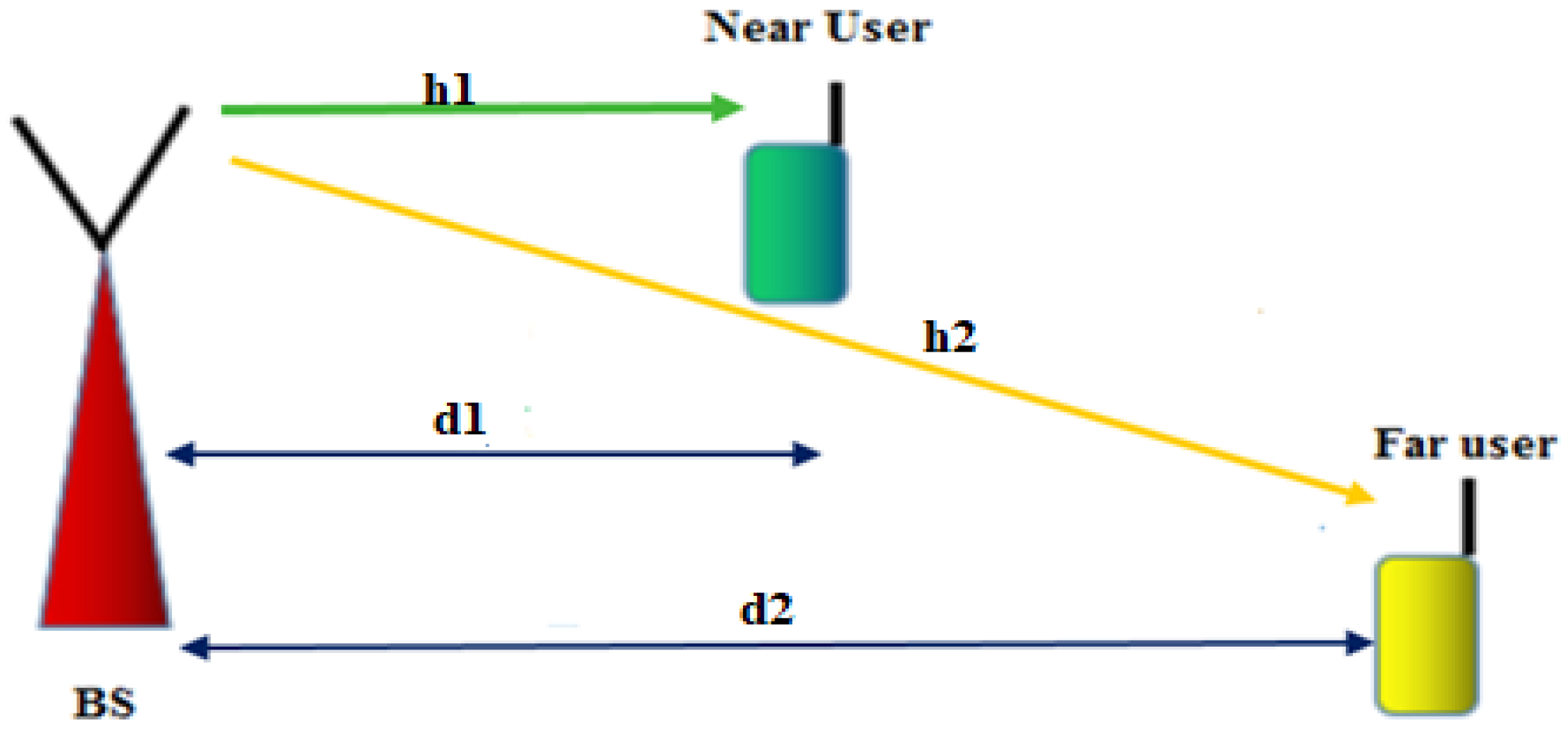
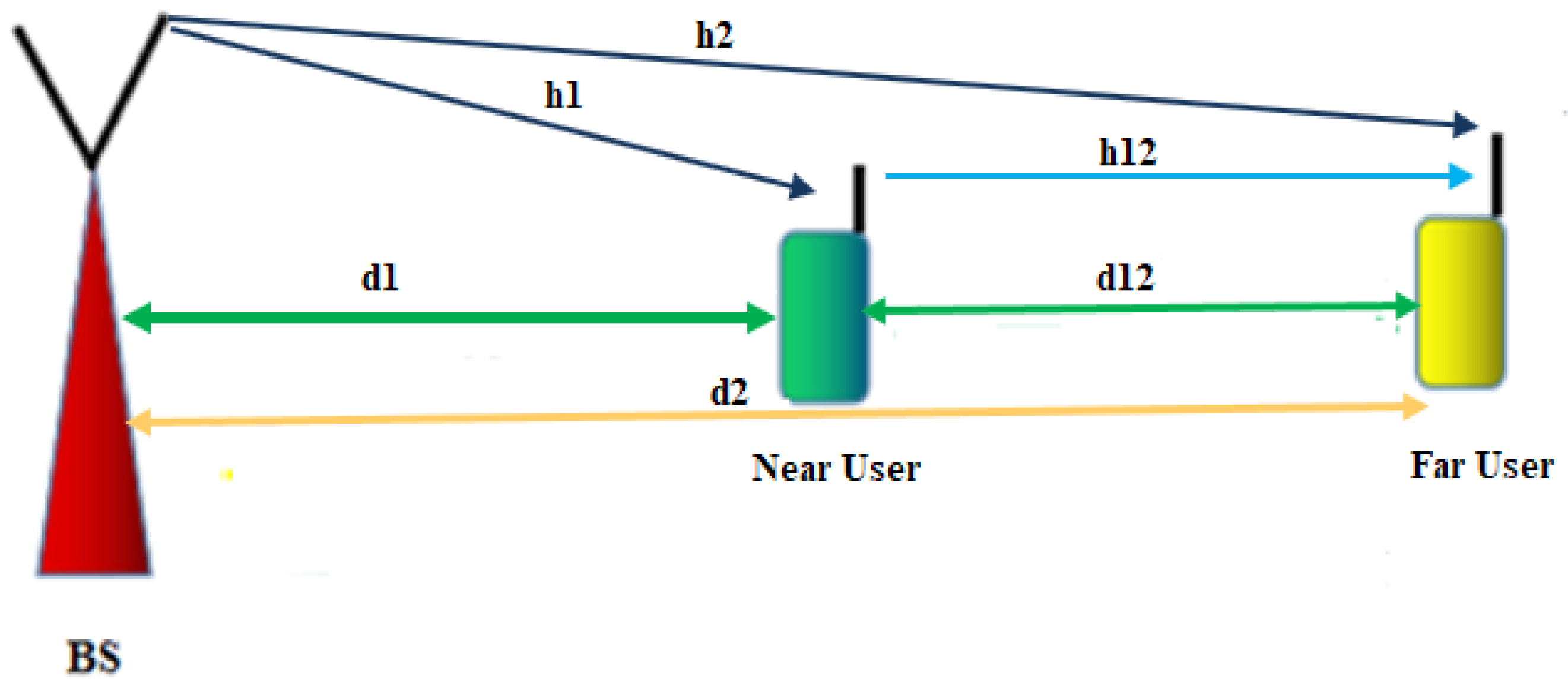
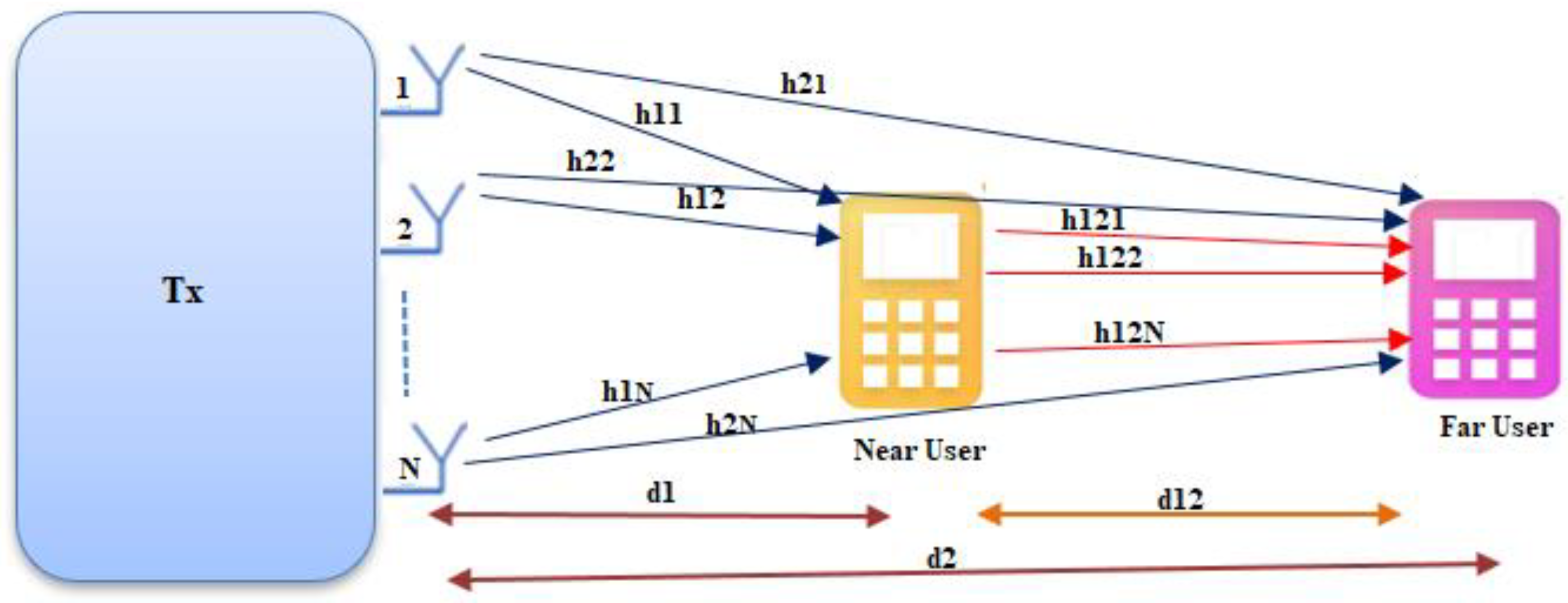


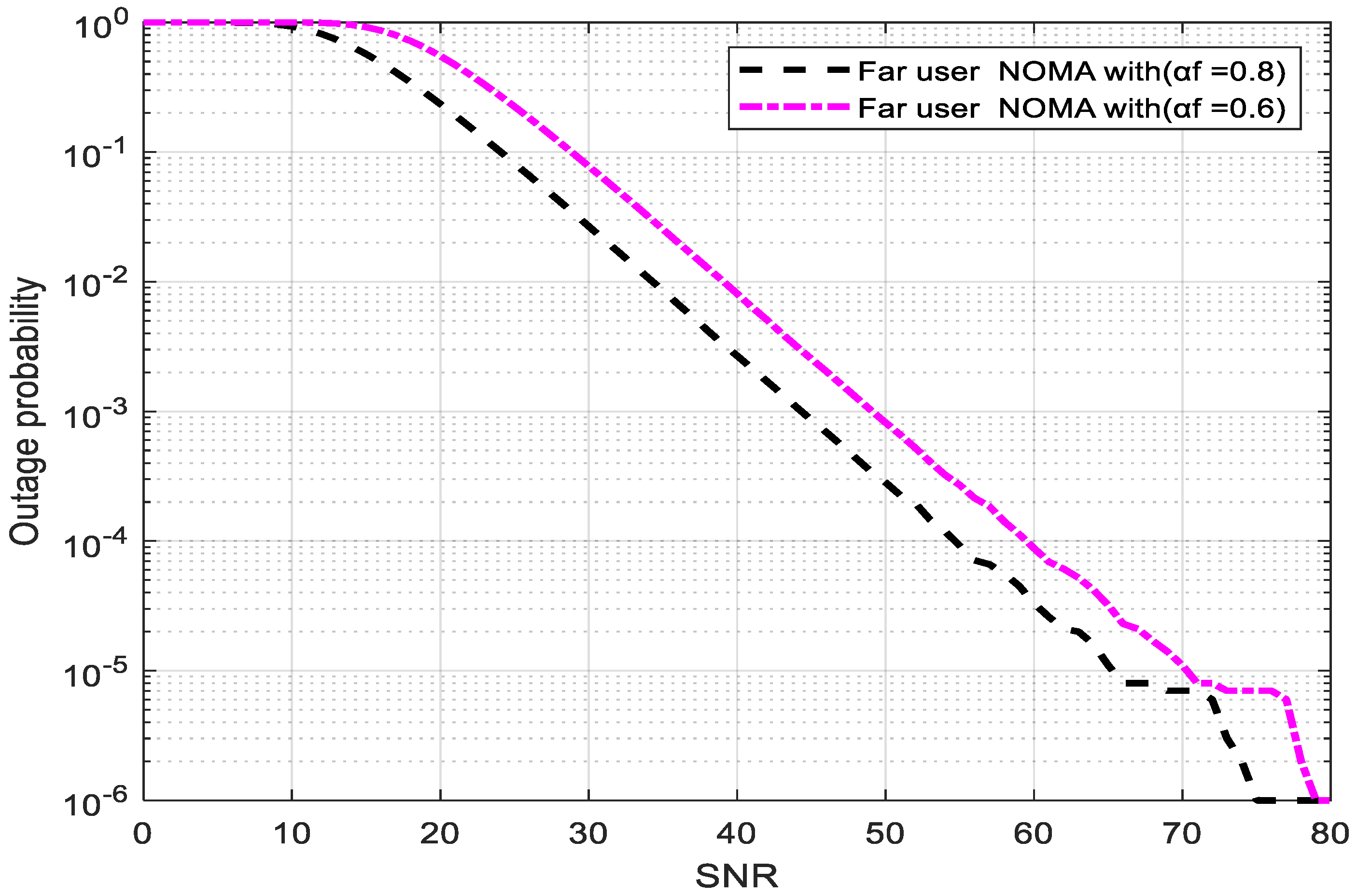

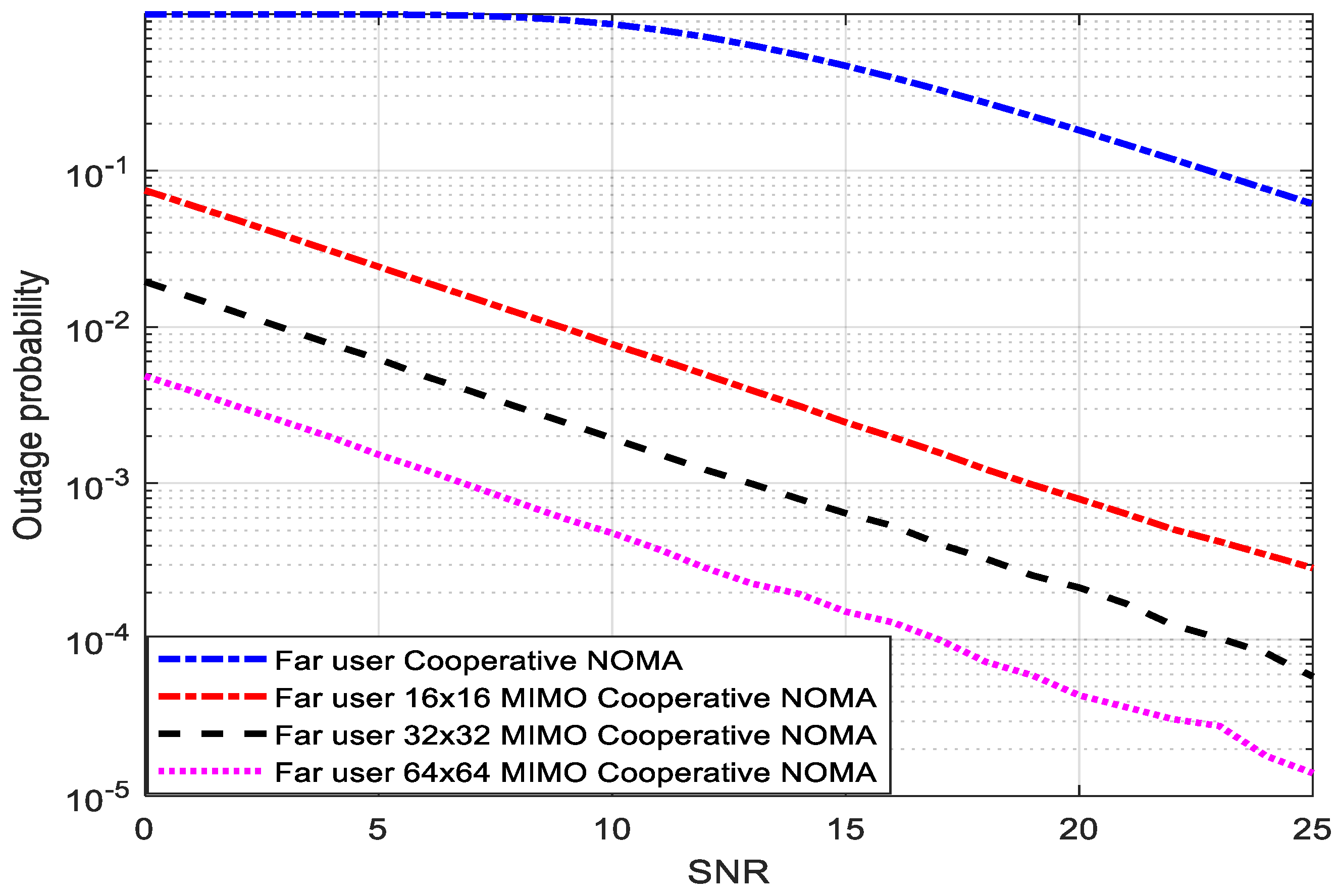
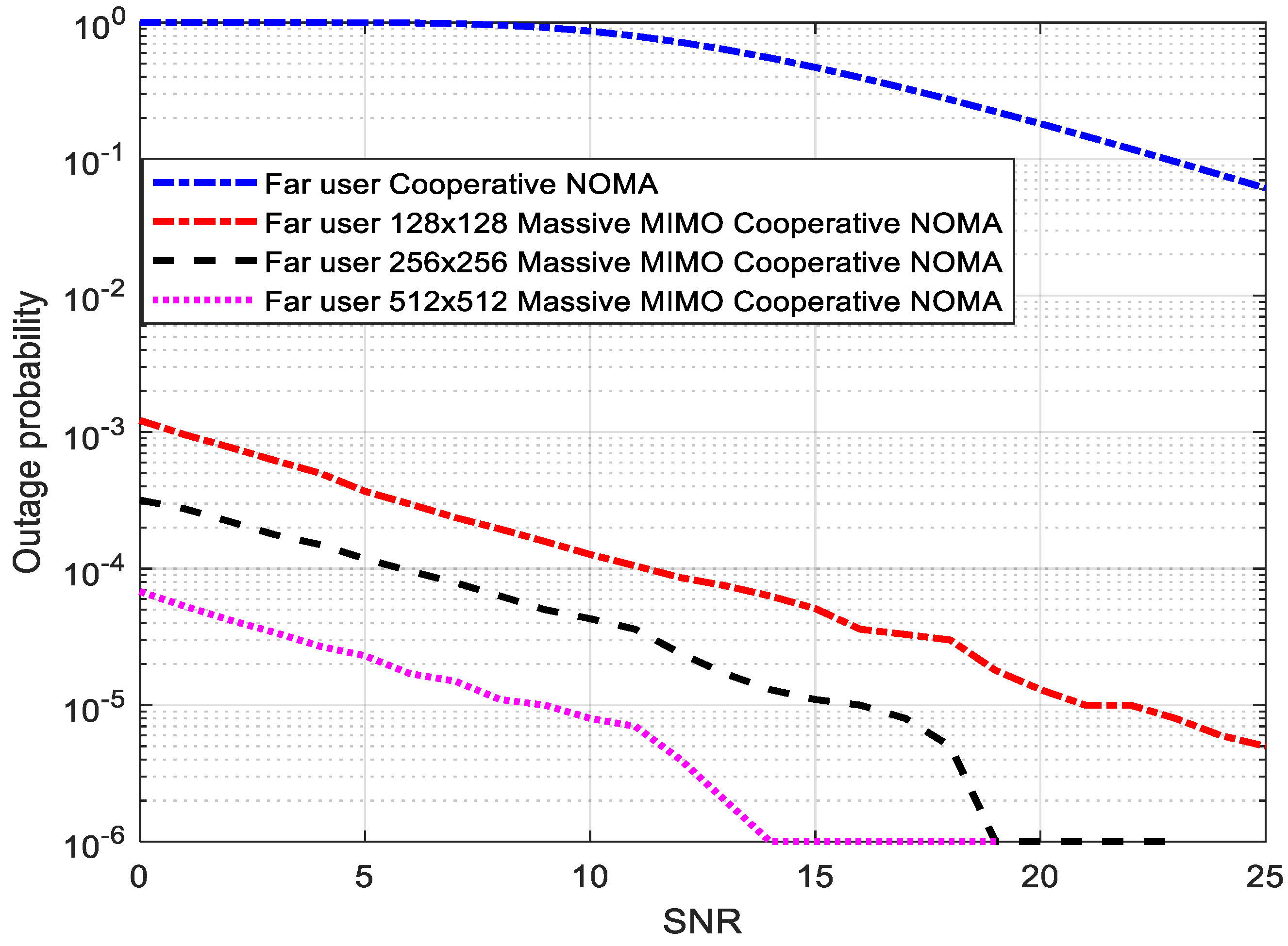
| Parameters | Values | |
|---|---|---|
| Distance | d2 = 2d1 | |
| SNR | 0–25 dB | |
| Slots | Direct Tx and Relaying slots | |
| Channel | Rayleigh fading | |
| Power allocation coefficients | αf | 0.9, 0.8, 0.7, and 0.6 |
| αn | 0.1, 0.2, 0.3, and 0.4 | |
| Path loss exponent | 4 | |
| The No. of bits per symbol. | 106 | |
| MIMO | 16 × 16, 32 × 32 and 64 × 64 | |
| Massive MIMO | 128 × 128, 256 × 256 and 512 × 512 | |
Publisher’s Note: MDPI stays neutral with regard to jurisdictional claims in published maps and institutional affiliations. |
© 2022 by the authors. Licensee MDPI, Basel, Switzerland. This article is an open access article distributed under the terms and conditions of the Creative Commons Attribution (CC BY) license (https://creativecommons.org/licenses/by/4.0/).
Share and Cite
Hassan, M.; Singh, M.; Hamid, K.; Saeed, R.; Abdelhaq, M.; Alsaqour, R. Design of Power Location Coefficient System for 6G Downlink Cooperative NOMA Network. Energies 2022, 15, 6996. https://doi.org/10.3390/en15196996
Hassan M, Singh M, Hamid K, Saeed R, Abdelhaq M, Alsaqour R. Design of Power Location Coefficient System for 6G Downlink Cooperative NOMA Network. Energies. 2022; 15(19):6996. https://doi.org/10.3390/en15196996
Chicago/Turabian StyleHassan, Mohamed, Manwinder Singh, Khalid Hamid, Rashid Saeed, Maha Abdelhaq, and Raed Alsaqour. 2022. "Design of Power Location Coefficient System for 6G Downlink Cooperative NOMA Network" Energies 15, no. 19: 6996. https://doi.org/10.3390/en15196996
APA StyleHassan, M., Singh, M., Hamid, K., Saeed, R., Abdelhaq, M., & Alsaqour, R. (2022). Design of Power Location Coefficient System for 6G Downlink Cooperative NOMA Network. Energies, 15(19), 6996. https://doi.org/10.3390/en15196996









